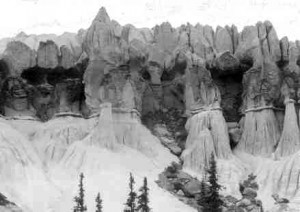Review by Ed Quillen
Wildfires – February 2000 – Colorado Central Magazine
Fire on the Mountain – The True Story of the South Canyon Fire
by John N. Maclean
Published in 1999 by William Morrow & Co.
ISBN 0-688-14477-2
ON JULY 6, 1994, at Storm King Mountain a few miles west of Glenwood Springs, a strong wind met a tinder-dry scrub-land that was already burning. The result was a “blow-up” — an instant, intense, and immense wall of flame that roared up the side of the mountain and killed 14 firefighters.
As John Maclean makes clear in Fire on the Mountain, those deaths were not the result of some mysterious force of nature, but of human error.
There are rules for cutting fire lines, and one major rule is to stay downhill of the fire — if it jumps the line, you’ve got a chance of outrunning it downhill, but a fire can always go uphill faster than you can. The Storm King firefighters were on the wrong side, and when the blowup came after them, they had to race it to the safe area at the top of Hell’s Gate Ridge. A few made it, but most didn’t.
But the errors extended far past the crews on the ground. The early summer of 1994 was hot and dry, and federal fire managers rightly feared the thunderstorm that moved across the Western Slope during the first days of July. It carried lightning but no rain, and started dozens of fires.
They had a meteorologist in the BLM’s Grand Junction office whose sole job was to issue weather forecasts for fire danger and fire fighting. He correctly predicted the arrival of a front with strong winds on July 6 — and the forecast was never transmitted to the fire crews, who should have been pulled off the mountain.
There were jurisdictional questions from the start — it was on BLM land, but residents kept calling the local fire departments, and the BLM had its own “extinguishment zone” and wasn’t sure whether the fire had crossed the line. As the fire grew and more crews arrived, administration became more complex and no one was really in charge of the situation.
And there’s the tragedy of the Prineville Hot Shots, mostly young people who used summer fire-fighting money for college.
This is a fairly straightforward journalistic account that covers the week from the lightning strike that smoldered for several days before spreading, to the deadly blowup and its immediate aftermath, as well as the results of several investigations.
Maclean calls this “the true story,” rather than “the full story,” and that’s a fair assessment. His writing, though sometimes choppy, is based on solid information, and he lays it out in a chronological way, even though that is sometimes difficult to follow.
There are some bigger questions that someone needs to address. The Storm King fire could not be allowed to just burn itself out, because it threatened houses where, only a decade earlier, there had just been meadow.
When counties allow developments in zones of high fire danger, and then young people die to protect those developments, who’s really at fault? No investigator addressed that, and neither does Maclean.
And what of similar zones of piñon, juniper and scrub oak, such as the stretch along the east flank of the Sangres from Salida to Westcliffe? Is it even possible to protect homes there, and if so, at what cost?
Those questions will confront us sooner or later, and Maclean doesn’t offer much guidance.
But he does tell a complex story in a generally clear way, and after you’re done, you’ll know what happened on Storm King and how it happened — and you’ll know the people, living and dead, who confronted Colorado’s deadliest wildfire.
— Ed Quillen

